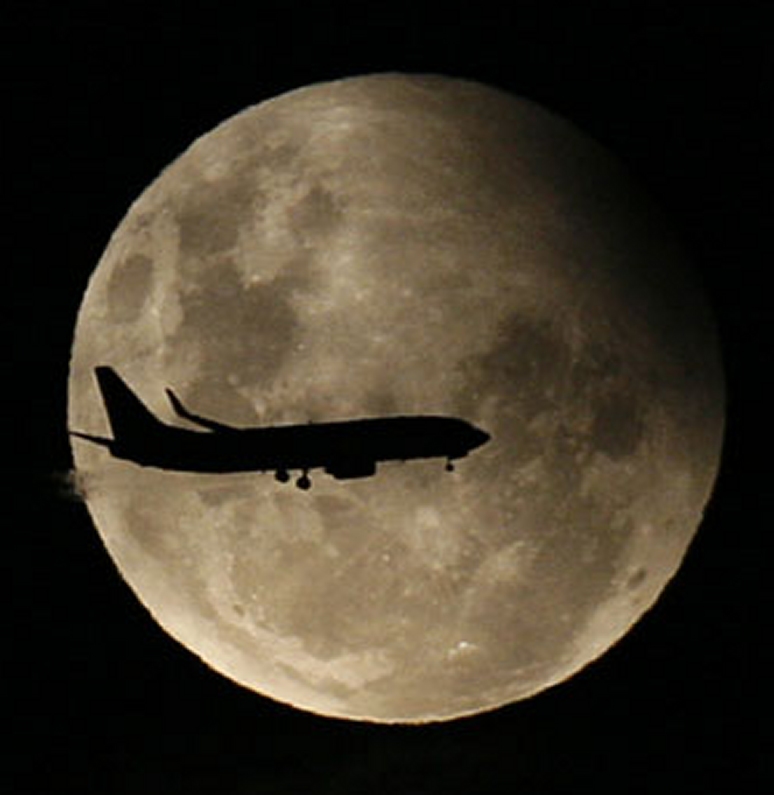 Blue Moon
Blue Moon
British Isles
1st January 2010 @ ~00.00 GMT
[Original unedited]
 Blue Moon
Blue Moon
[The same photo as above with a Blue Tint added using Paint Shop Pro!]
 Blue Moon in partial eclipse
31 December 2009 Blue Moon in partial eclipse
31 December 2009
Passenger jet over Cape Town [Southern Hemisphere Moon]
References:
[1] What's a Blue Moon? The trendy definition of "blue Moon" as the second full Moon in a month is a mistake. Sky and Telescope - the Essential Guide to Astronomy (retrieved 30 August 2012)
by Donald W. Olson, Richard Tresch Fienberg, and Roger Sinnott.
www.skyandtelescope.com/observing/objects/moon/3304131.html
[2] The New International Ephemerides 1900 - 2050 @ 0 heure. (1993) Editions St. Michel, 07200 St-Michel-De-Boulogne, France

Follow the Moon every starlit night throughout the year with a beautiful blue and silver screen-printed wall mounted Lunar Chart (Calendar), Moon Magnet Cards and Silk Moon Scarves showing the phases of the Moon throughout the year. |
|
 |
What is a Blue Moon?
Nowadays, a 'blue moon' is the name given to the second full moon appearing in a single month. This phenomenon occurs roughly every two and a half years when a calendar year includes 13 full moons. As this does not occur monthly like a full moon, the expression 'once in a blue moon' is used to refer to an event that occurs infrequently.
What are the dates of a Calendrical Blue Moon?
In July 2015, the first full Moon occurred on 2nd July in Capricorn and the second Full Moon on 31st July [10:44 GMT] is a Blue Moon in Aquarius. The previous calendrical Blue Moon occurred in August 2012 (2nd & 31st) and before that in December 2009 (first full moon occurred on 2nd and the second on 31st December).
The following months contain a Blue Moon:
- July 2015
- January & March 2018 (with no Full Moon in February)
- October 2020
[Photos on left are from the second 'Blue' Moon on December 31st 2009 and early on January 1st 2010. It also happened to be a partial eclipse.]
Original Blue Moon in the Tropical Year
Research into old copies of the Maine Farmer's Almanack[1] prior to 1962 reveal that a Blue Moon was originally based on the Tropical Year. This divided the solar year into four seasons based on the Solstices and Equinoxes. Whenever there were four Full Moons during a season, the third Full Moon was considered a Blue Moon. The reason for this was that Farmers had names for all other full moons:
- January: Wolf Moon, Old Moon, Moon after Yule
- February: Snow Moon
- March: Worm Moon, Crow Moon
- April: Seed Moon, Pink Moon, Egg Moon, Fish Moon
- May: Milk Moon, Flower Moon
- June: Strawberry Moon, Rose Moon, Thunder Moon
- July: Hay Moon, Buck Moon, Thunder Moon
- August: Corn Moon, Sturgeon Moon, Grain Moon
- September: Harvest Moon
- October: Hunter's Moon
- November: Beaver Moon, Frosty Moon
- December: Oak Moon, Moon before Yule, Long Nights Moon
The original quarterly Blue Moons normally occur between 20th and 23rd of the month when the Sun was on the cusp between the fixed and mutable signs of the zodiac.
Here are some dates of the original quarterly Blue Moon (based on GMT times) showing the Sun/Moon sign position:[2]
- 21 November 2010 Scorpio/Taurus
- 21 August 2013 Leo/Aquarius
- 21 May 2016 Gemini/Sagittarius
- 19 February 2019 Pisces/Virgo
Can the Moon be Blue?
A 'blue moon' is not actually blue. However, at any time of the lunar cycle when there is smoke or volcanic dust in the atmosphere, the Moon can appear to have a bluish hue when viewed from Earth. On September 26, 1950, after severe forest fires swept across Canada and filled the upper atmosphere with smoke particles, people in Britain reported a blue moon. [Source: Sunday Times Magazine, p.7, 24 Aug. 2014]
Is a Blue Moon significant to Astrologers or Astronomers?
The 'Blue Moon' phenomenon is based on the Gregorian (western) calendar with a year divided into 12 months. As this monthly division is a human construct without a celestial correlation, the calendrical Blue Moon holds no significance to astrologers or astronomers. It is likely that the old tropical Blue Moon with thirteen Full (or indeed 13 New) Moons within a Solar Year would be significant to some astrologers.

Compiled by Robert Currey
|  |
|